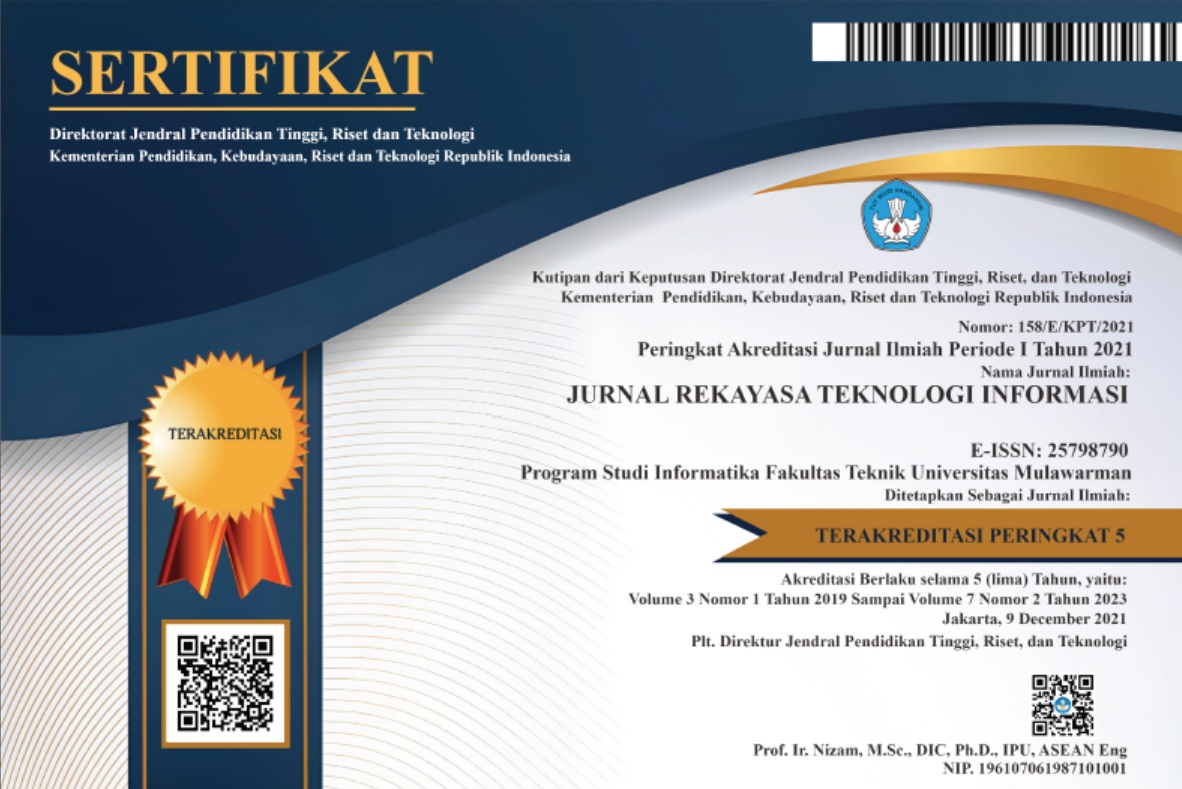Integrasi Normalized Relative Network Entropy Dan Neural Network Backpropagation (BP) Untuk Deteksi Dan Peramalan Serangan DDOS
Abstract
Full Text:
PDFReferences
Hackmageddon. Intranets: I know with what weapons World War III will be fought. [Online]. Available: http://hackmageddon.com/page/4
Bloomberg BussinessWeek. Intranets: You Don’t have to be an Evil Hacker Genius to bring Down PlayStation. [Online]. Available: http://www.businessweek.com/articles/2014-08-26/ddos-attacks-aresoaring
R. Heady, G. Luger, A. Maccabe, M. Servilla, 1990. The architecture of a Network Level Intrusion Detection System, Technical Report CS90-20, University of New Mexico, August.
eSecurity Planet. Intranet: DDoS attack growing but how much. [Online]. Available: http://www.esecurityplanet.com/networksecurity/ddosattacks-growing-but-how-much.html
A. Tajbakhsh, M. Rahmati, and A. Mirzaei. 2009 “Intrusion Detection Using Fuzzy Association Rules”, Applied Soft Computing, vol. 9, no. 2, pp. 462-469.
Yu, H. Lee, M.S. Kim, and D. Park. 2008. “Traffic flooding attack detection with SNMP MIB using SVM”, Computer Communications, vol. 31, no. 17, pp. 4212-4219.
G. Thatte, U. Mitra, and J. Heidemann. 2011. “Parametric Methods for Anomaly Detection in Aggregate Traffic”, IEEE/ACM Trans. Networking, vol. 19, no. 2, pp. 512-525, April.
S. Lee, G. Kim and S. Kim. 2011 “Self-adaptive and dynamic clustering for online anomaly detection”, Expert Systems with Applications, vol. 38, no. 12, pp. 14891-14898.
Yu Gu, A.McCallum and D.Towsley. “Detecting Anomalies in Network Traffic Using Maximum Entropy Estimation” Tech. rep., Department of Computer Science, UMASS, Amherst, 2005. In https://www.usenix.org/events/imc05/tech/full_papers/gu/gu.pdf
Qian Quan, Che Hong-Yi, Zhang Rui. 2009. “Entropy Based Method for
Network Anomaly Detection“. 15th IEEE Pacific Rim International Symposium on Dependable Computing, vol. 978-0-7695-3849-5, no. 09, pp.189-191.
MIT: Mit lincoln laboratory-darpa intrusion detection evaluation.
http://www.ll.mit.edu/mission/communications/ist/corpora/ideval/index.html (1999)
The CAIDA UCSD "DDoS Attack 2007" Dataset
http://www.caida.org/data/passive/ddos-20070804_dataset.xml
The CAIDA UCSD Anonymized Internet Traces 2011 - http://www.caida.org/data/passive/passive_2011_dataset.xml
https://www.usenix.org/legacy/event/deter07/tech/full_papers/mirkovic/mirkovic_html/DeterPerfs.html
G. Nychis V. Sekar, D. G. Anderson, etc. 2008. “An Empirical Evaluation of Entropy-based Anomaly Detection” Proceedings of the 8th ACM SIGCOMM conference on Internet measurement,, ACM Press, pp151-156.
D.Brauckhoff, B. Tellenbach, A. Wagner, etc. 2006. “Impact of traffic sampling on anomaly detection metrics.” Proceedings of the 6th ACM SIGCOMM conference on Internet measurement. ACM Press, pp159-164.
A.Lakhina, M. Crovella, and C. Diot. 2005. “Mining anomalies using traffic feature distributions”. Proceedings of the 2005 conference on Applications, technologies, architectures, and protocols for computer communications.ACM Press, pp217-218
S.A. Mirheidari, S. Arshad, and R. Jalili, 2013 “Alert Correlation Algorithms: A Survey and Taxonomy”, In Cyberspace Safety and Security, pp. 183197, Springer International Publishing.
J. Viinikka, H. Debar, L. Mé, and R. Séguier.2006. “Time series modeling for IDS alert management”, In Proceedings of the 2006 ACM Symposium on
Information, computer and communications security, pp. 102-113, March.
R. Smith, N. Japkowicz, M. Dondo, and P. Mason. 2008. “Using unsupervised learning for network alert correlation”, In Advances in Artificial Intelligence, pp. 308-319, Springer Berlin Heidelberg.
D. Bolzoni, S. Etalle, and P.H. Hartel. 2009. “Panacea: Automating attack classification for anomaly-based network intrusion detection systems”, In Recent Advances in Intrusion Detection, pp. 1-20, Springer Berlin Heidelberg, January, 2009
DOI: http://dx.doi.org/10.30872/jurti.v1i1.630
Refbacks
- There are currently no refbacks.
Copyright (c) 2017 JURNAL REKAYASA TEKNOLOGI INFORMASI

This work is licensed under a Creative Commons Attribution-NonCommercial-ShareAlike 4.0 International License.
Alamat Redaksi :
Program Studi Informatika
Fakultas Teknik
Jl. Sambaliung No. 9 Kampus Gunung Kelua Samarinda 75119 - Kalimantan Timur
e-mail : jurti.unmul@fkti.unmul.ac.id
Url : http://e-journals.unmul.ac.id/index.php/INF
Contact Person : Medi Taruk [081543438301]
This work is licensed under a Creative Commons Attribution-ShareAlike 4.0 International License.











